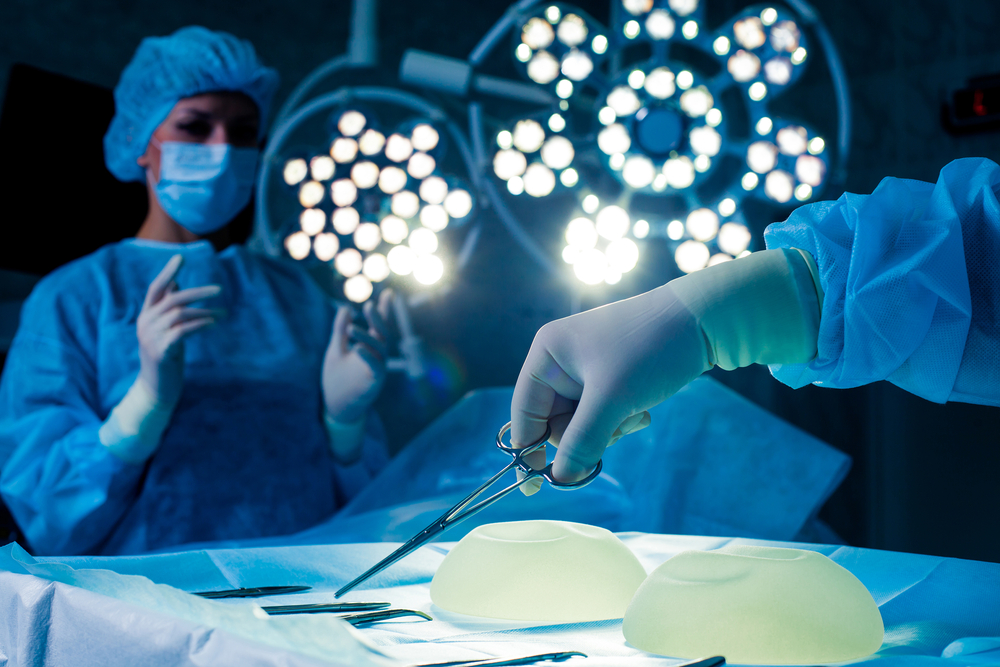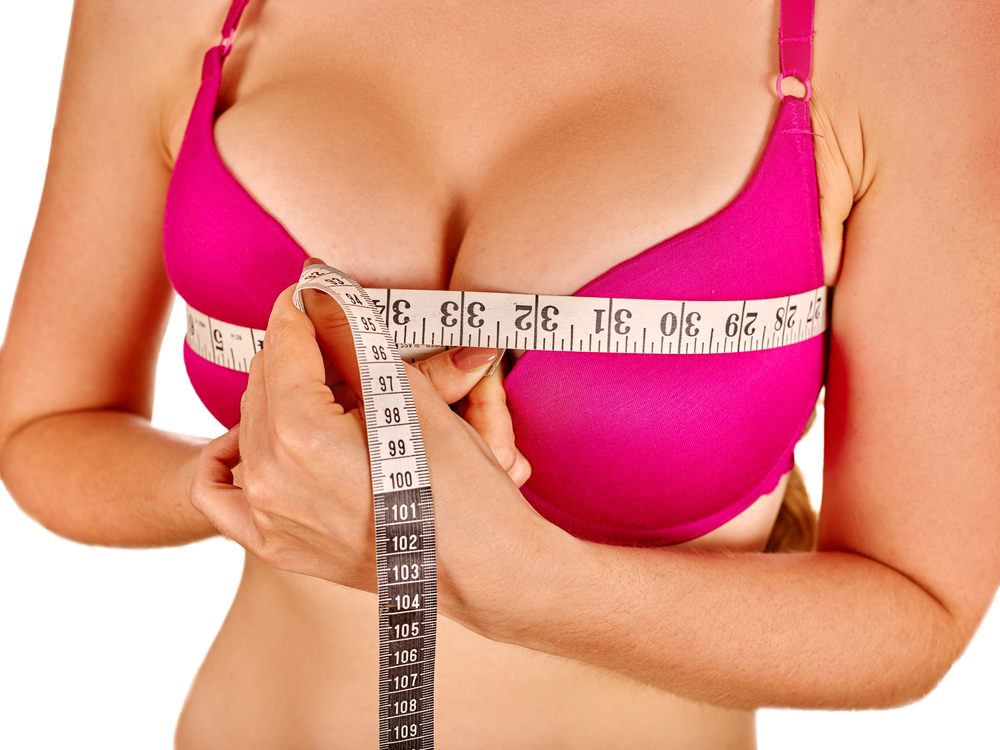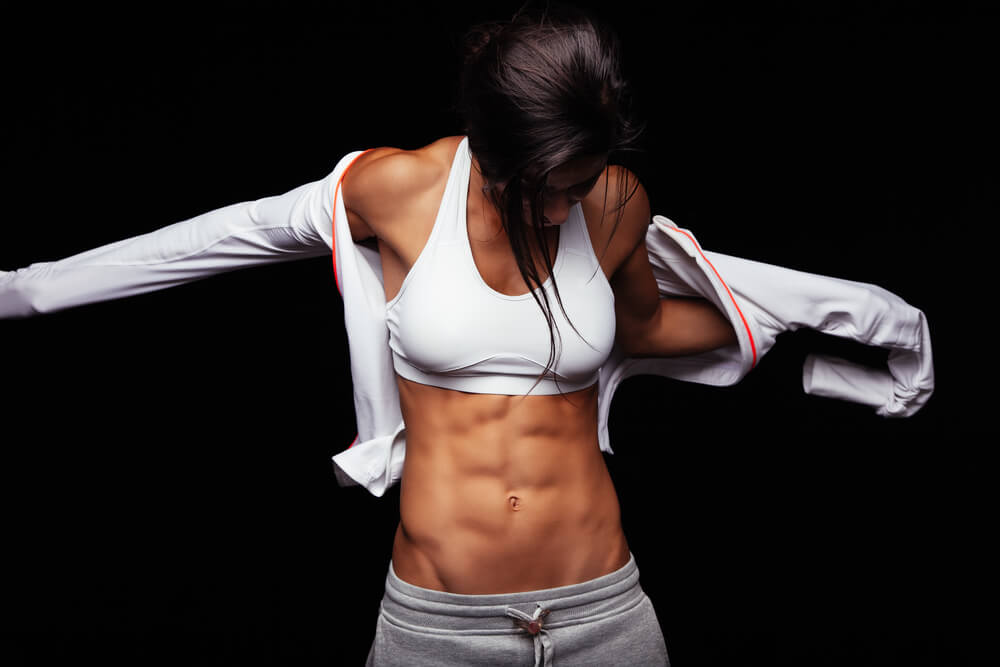
As any female athlete knows, living a fitness-focused lifestyle can greatly impact your body—largely for the better.
When you begin regular exercise and follow a simple diet plan, the body begins gravitating toward a more athletic build with very low body fat and an increase in lean muscle. Some women, however, may be concerned with how these changes affect their breasts.
How an Athletic Lifestyle Can Impact Your Breasts
As your body fat lessens, the overall volume of the breasts can decrease, the natural shape of your breasts may change, and the proportions of your body may be altered. As this happens, breast asymmetry and an un-proportional appearance may also affect the breasts, causing some women to feel self-conscious.
Many of my patients have reported feeling they have sacrificed some of their femininity though they are thrilled with improved appearance of the rest of their bodies.
For some competitive athletics or sports, such as bodybuilding, there are additional factors. Many judges of female bodybuilding competitions prize both a feminine aesthetic and well-defined musculature—two things that can be difficult to naturally achieve at the same time.
All of these factors contribute to many athletic women pursuing breast augmentation surgery.
![]()
3 Reasons Why Female Athletes Consider Breast Augmentation
For women who have any of the above concerns, it may be worth your while to speak with a board certified plastic surgeon about your boob jobs. Breast augmentation surgery involves the placement of saline or stable silicone filled breast implants to increase breast volume, improve breast shape, and correct issues such as asymmetry or tubular breasts.
#1 A safe choice for enhancing your breasts
When performed by an experienced surgeon, breast augmentation is a straightforward procedure with a relatively easy recovery period. In recent years, the techniques of surgery and improved design and composition of implants themselves have greatly reduced the risk of complications, making breast augmentation a very safe choice.
Breast augmentation is one of the most popular cosmetic surgery procedures and it has some of the highest patient satisfaction ratings, with a 98% “Worth It” rating on RealSelf.com, a popular online community focused on cosmetic enhancement. It’s the second most performed cosmetic procedure in the United States, with over 286,000 procedures performed in 2014 alone.
#2 A variety of options to suit your lifestyle & desired results
Many folks are under the impression that all augmented breasts look the same: overly large, overly high, and overly round. Luckily, this isn’t the case. These days, there are a myriad of options and techniques to choose from, making your breast augmentation results completely unique to you. The choice is yours: you can go for an augmented look with fullness at the top of the breast; or you can choose to have more natural-looking results. Here are a few examples:
- Breast implant material: implants are available in silicone and saline, both of which provide beautiful, though different feeling, results.
- Breast implant shape: available in either round or anatomical (teardrop), the shape of your implants will greatly impact the final look.
- Breast implant profile: available from moderate to high, the profile of your breast implant affects how far out from your body your breasts will project.
- Breast implant size: breast implant volume is measured in cubic centimeters (cc) and can range in size. Your implants will be filled individually to ensure a symmetrical look.
You will work closely with your chosen surgeon to design a treatment plan and determine the best options for your natural anatomy and desired final look. You can even “try on” implants! During a fun sizing session, you will have the opportunity to place implant sizers in your bra to get a general idea of size and shape—and some offices even offer 3D imaging to visualize results.
#3 Investing in yourself isn’t as expensive as you think
Plastic surgery, and breast augmentation in particular, is no longer reserved for the rich and famous. You may be surprised to learn that breast augmentation isn’t nearly as expensive as you might think it is: qualified surgeons typically offer the procedure in the $5,000 to $7,000 range. While that price tag may seem high, it typically covers the cost of breast implants, surgeon’s fees, necessary medical supplies, use of the surgical facility, and follow-up appointments.
Because most of us don’t have thousands of extra dollars lying around, there are also alternative payment and financing options available to help make paying for surgery comfortable for you. There are a number of trusted third-party financing companies that are specifically designed to help patients with health care and plastic surgery costs. Most plastic surgeons work with one or more of these companies and are often willing to help you gain pre-approval on financing so you can get started right away.

Breast Augmentation Techniques for Athletic Women
For women with low body fat and minimal natural breast tissue, getting beautiful results requires the expertise of a plastic surgeon with advanced knowledge of female anatomy. Athletic women simply have less fat to hide any flaws or variations in implant placement, so the surgeon’s experience and technique is much more critical. You’ll also want to choose the best to be sure you are safe throughout the process, have an optimally short recovery, and can get back to your training sooner.
As a former bodybuilder and Men’s Physique Competitor, I have a unique perspective on the nuances of performing breast augmentation on women with muscular frames and little body fat—and my long experience working with female athletes has given me a great understanding of what works best.
Here are a few things to consider:
- How big can you safely, comfortably, and successfully go, considering your natural breast size and lifestyle?
- What type of athlete are you? Do you work your upper body a lot?
- What type of look are you hoping for?
All of these things will help determine the best technique and options for you. With any patient I see, a consultation is necessary to determine which options will best suit their needs. While many female athletes benefit from newer generations of silicone implants in the smaller range, your size, shape, and profile will all be chosen based on individual body measurements and determined on a case by case basis.
A smaller size may be your best bet
For those without much natural breast tissue, which is often the case for female athletes, a more modest increase in size may produce the best results. During consultations, I evaluate the musculature and frame of the patient to determine what implant size will provide the best results. Breasts that are too large can appear unbalanced and unnatural, while implants that are too small can look out of proportion with the rest of the body. For these reasons, I base my recommendations for female bodybuilders on their unique anatomy and future goals.
Choosing to subtly enhance the breasts not only creates a more natural look that complements a thinner or more athletic physique, it also reduces the risk of implant rippling and palpable edges (seeing or feeling the breast implant under the skin)—a complication that can affect women without much natural tissue to cover the implant. While smaller-sized implants are often a good match for muscular frames with less body fat, some patients require larger implants to create a proportionate, attractive result.
The Best Breast Implant Placement
Breast implants can be placed either over the pectoral muscle and under the glandular breast tissue (sub glandular), or under the chest muscle (submuscular). For my thin or athletic patients, I generally recommend that implants be placed under the pectoral muscle.
Implants placed under the pectoral muscle tend to create a more natural look for slimmer women by helping to compensate for the lack of fatty tissue and overall toned appearance. Additionally, implants placed under the muscle often move more naturally within the breast pocket—and on smaller patients, it reduces the risk of looking like the implants are “floating” on your chest.

Saline vs. Silicone for Fit Women
Breast implants come in either saline or silicone, and while both can produce beautiful results, there are some differences:
- Saline breast implants are comprised of a silicone rubber outer shell that is filled with sterile saline solution (salt water) after they have been placed. Saline implants come in either round or teardrop shapes.
- Silicone breast implants are pre-filled with a safe, cohesive silicone. Like saline implants, silicone implants come in both round and anatomical shapes.
For women with little body fat, silicone implants are typically preferred, as saline implants can result in higher rates of rippling in women who do not have sufficient tissue to conceal the implant. Silicone also results in a very natural look and feel, which is a bonus for women hoping to make a natural-looking, subtle enhancement.
Depending on a patient’s preferred look, highly cohesive, 5th generation silicone gel implants may also offer great results. Often referred to as “gummy bear implants” because of their firm yet pliable consistency, these implants are comprised of a form-stable silicone gel and available in both round and anatomical shapes. For slimmer women with less natural breast tissue, the teardrop-shaped version can provide beautiful results that mimic the shape of natural breasts.
INSPIRA™ implants, the latest to gain FDA-approval, may also be a good fit for athletic women. These round, overfilled silicone gel implants effectively share the advantages of both regular silicone gel implants and gummy bear implants—without any of the disadvantages. In my experience, these implants really support upper pole fullness for a youthful, shapely appearance, but remain softer than highly cohesive silicone gel implants and have no risk of implant rotation. A bonus for slimmer women is that there is a greatly reduced risk of implant rippling due to the higher fill volume.
Returning to Your Active Life: Breast Augmentation Recovery
Many of my athletic patients are concerned about their breast augmentation recovery period and wonder when they can return to training. The good news is that while you will need to take some downtime, the breast augmentation recovery process is typically quick.
When can I start exercising again?
Every patient is different, and both the technique used for your surgery and your personal health will play a role in your recovery. Some patients heal faster than others, but you can expect your recovery timeline to look a little something like this:
- Day of Surgery: While you can return home the same day of your procedure, you will need a designated driver and temporary helper (enlist a “booby buddy” or “breast friend”!), as you will still be under the effects of anesthesia. You likely won’t want to do more than rest with a good book or some TV shows for the day. Other than walking, activity should be restricted.
- Day 4: By the third or fourth day after surgery, you should be feeling quite a bit of improvement. Many patients return to desk jobs at this point, and normal activity can be slowly resumed. Patients can typically drive, lift normally weighted objects, and slowly raise their arms (think washing your hair) at this point. Strenuous activity should still be avoided, and you need to pay attention to anything that raises your blood pressure or puts strain on your healing incisions.
- Day 7: One week in, you can start resuming a light cardio routine. Begin slowly with brisk walking and work your way to more aerobic activity as your body acclimates and you feel more comfortable over the next few weeks—listen to your own body and your surgeon with regard to your activity level. Don’t forget to wear a bra that supports your new breasts without constricting the implants.
- Day 14: Weight training should be avoided entirely for at least two weeks—you likely won’t feel like doing it anyway. Again, start slowly at this point. Your body is recovering from surgery, and you likely won’t be able to pick up right where you left off.
- Week 6: By six to eight weeks, most patients are ramping up their activity and feeling more and more like themselves. Your incisions should be totally healed at this point, and muscle movement should be coming easier. Upper body lifting may be slowly resumed within the boundaries of your personal comfort, and your surgeon’s recommendations.
- Month 3: Within three months, you should be at or near your pre-surgery fitness routine. Your breast appearance may still be changing as the implants settle into position, but you should not be feeling any discomfort associated with activity at this point.
Keep in mind that these are general guidelines; follow your own surgeon’s aftercare instructions and report anything unusual to them. Also, be sure to go to all of your follow-up appointments!
Is it safe to do chest exercises after breast augmentation?
It is safe to continue exercising your chest, but only after you have fully healed. If your implants were placed under the pectoral muscle, it is essential to give the chest muscles time to heal properly before putting any stress or strain on them. I generally recommend waiting at least six to eight weeks after surgery to resume intensive chest exercise routines.
Be sure to proceed with caution during the first few exercise sessions—and don’t forget to discuss your regular fitness routine with your surgeon so you can approach activity safely. Push-ups and weight training are allowed after a full recovery, but patients may experience some discomfort or tightness as they resume weight lifting activities.
How will this time off impact my fitness level?
Taking time off from your normal activity can be psychologically difficult, and many patients wonder how it will impact their overall fitness. Since training is discouraged during the healing process, some patients may experience an initial loss of strength gains immediately following surgery. This should be easily built back up once you have recovered, and it should not permanently affect you.

How to Get Started: Choosing the Right Surgeon
After you have decided to have breast augmentation surgery, perhaps one of your most important choices is which plastic surgeon will perform the procedure. Here are a few things to look for when “shopping” for the right plastic surgeon for you:
- Make sure to choose a surgeon who is board-certified by the American Board of Plastic Surgery. This shows they have received the proper education and training necessary to provide safe results. You can check on a surgeon’s certification through the Board’s surgeon search tool.
- Look for a plastic surgeon who has extensive experience with breast augmentation. Read testimonials of other breast augmentation patients, view before and after images, and ask the surgeon about their experience. Someone who has worked with many athletic women is likely an ideal match.
- Most surgeons have a before and after patient gallery on their websites (and a more extensive batch of photos in their office). Look for images of women who have a similar body type to your own. This will help you get an idea of a surgeon’s results and can also guide you in choosing your implant options. Keep in mind that a patient’s desires play a big role in final results. If you see an image that doesn’t look ideal to you, talk to the surgeon about it. It could be that it is the “look” the patient wanted, or even a shot taken before the breasts had fully settled into their final position.
It is okay, and recommended, to speak with multiple surgeons so you can find your perfect fit. Many practices offer low-cost consultations, making it a low-risk opportunity to learn more about the procedure and get to know your surgeon. While some surgeons offer free consultations, you may receive more personal attention, valuable information, and time when you pay for your consultation. Additionally, if you choose that surgeon, your consultation fee will often go toward the total price of your procedure.
I hope this guide has proven helpful for those considering breast augmentation to restore volume and shape to the breasts, in addition to boosting confidence.
About the Author: Gregory Buford, MD, FACS is a Denver-based, board certified plastic surgeon and owner of BEAUTY by BUFORD. He has been providing patients with beautiful breast augmentation results for over 20 years and is nationally recognized for his expertise in breast enhancement surgery. As a former bodybuilder and Men’s Physique Competitor with a 1st place finish in the Master’s 45 and over category, Dr. Buford has vast experience working with competitive fitness models and female bodybuilders to restore a full, feminine appearance to the breasts.
Latest posts by Terry M (see all)
- Garage Gyms - Aug 1, 2018
- Kettlebells – Why They Should Be Added To Your Routine. - Jul 24, 2018
- Weight Belts: What Are They Really For? - May 31, 2018










Quite useful article. Breast augmentation is a good choice for female athletes who may change the natural shape of breast due to regular body building.
Thanks for stopping by Craig!
Terry Asher
I agree. Getting the right plastic surgeon is at most important to ensure quality results.
[…] an athlete, you should keep in mind that breast augmentation might not be a one-shot deal. Females who work out put much more stress on their implants than […]
[…] an athlete, you should keep in mind that breast augmentation might not be a one-shot deal. Females who work out put much more stress on their implants than […]
They look good with it!